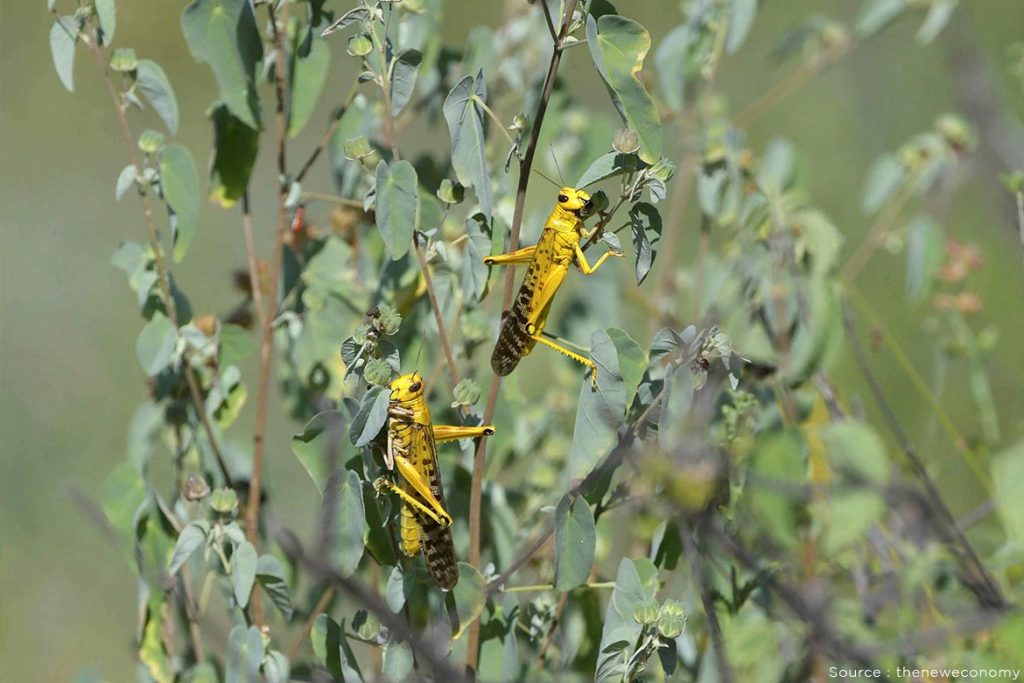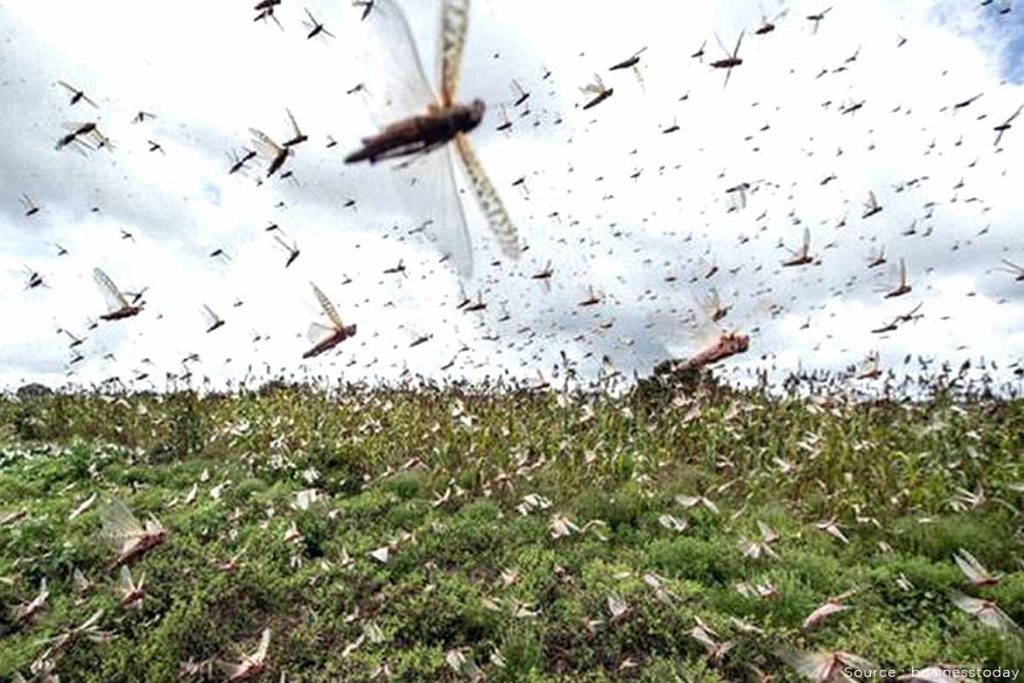When the world is already struggling enough to deal with the coronavirus pandemic, now we have another grave problem to deal with, this problem is now being caused due to the desert locusts. These locusts have now reached India, after causing havoc in the countries like Ethiopia, Somalia, Iran, and Pakistan and so on. Let’s have a look in greater detail.
| TABLE OF CONTENTS What is Desert Locust? How many species of locusts are there in world and India? What is the history of locust invasion in India? What other countries are affected by the Desert Locust? How far and how fast can Desert Locusts migrate? How can they be controlled? What are the steps being taken by various authorities in this regard? |
What is Desert Locust?
Desert locusts are short horned grasshoppers; the species is known as Acridoidea. They are more popular as they have the capability of changing their behavior and thus, they form their swarm which includes adult hoppers. These hoppers form their swarms which are actually very densely populated as well as highly mobile. These locusts can be very destructive and this can be easily understood by a fact that they eat the amount of food which is equivalent to their weight. And in just one day a swarm of these locusts can feed on the quantity of food which actually could be sufficient for feeding 2,500 people in a day.
How many species of locusts are there in world and India?
Locusts are the oldest migratory pests in the world, according to the Food and Agriculture Organization (FAO). In total, currently there are 10 identified species of locusts which can be found in different parts of the world. These ten are listed below:
The Desert Locust, the Bombay Locust, the Migratory Locust, the Italian Locust, the Moroccan Locust, the Red Locust, the Brown Locust, The South American Locust, The Australian Locust, The Tree Locust.

But, when we are viewing it in context of India, then here we find only four types of locust which are, Desert locust (Schistocerca gregaria), Migratory locust (Locusta migratoria) Bombay Locust (Nomadacris succincta) and Tree locust (Anacridium sp.). Here, the desert locust holds greater importance as a pest in India as well as in many other countries.
What is the history of locust invasion in India?
Even in the past, the Desert Locust has always been a major threat to man’s well-being. Desert locusts are even said to be as a curse to the mankind as per the ancient writings. They even hold their mention in the Holy Quran and also in the Old Testament Bible. The magnitude of the damage and loss caused by the locusts is very gigantic beyond imagination as they have caused starvation due to its being polyphagous feeder. Locust do cause damage by devouring the leaves, flowers, fruits, seeds, bark and growing points and also by breaking down trees because of their weight when they settle down in masses.
“The current locust outbreak is the biggest in 25 years in Ethiopia and Somalia, 26 years in India, 70 years in Kenya,” Keith Cressman, locust forecasting officer at FAO told PTI.

What other countries are affected by the Desert Locust?
The invasion area of desert locust covers about 30 million sq km which includes whole or parts of nearly 64 countries. This includes countries like North West and East African countries, Arabian Peninsula, the Southern Republic of erstwhile USSR, Iran, Afghanistan, the Indian sub-continent. During recession periods when locust occurs in low densities, it inhabits a broad belt of arid and semi-arid land which stretches from the Atlantic Ocean to North West India. Thus, it covers over 16 million sq. km in 30 countries.
How far and how fast can Desert Locusts migrate?
Also these locusts can even cover long distances even of up to 150 km in a single day, which again makes them much more harmful for the mankind. They usually fly with the wind at a speed of about 16-19 km/h depending on the wind. They are even capable of staying in the air for long periods of time. For example, locusts regularly cross the Red Sea, a distance of 300 km.
#WATCH Madhya Pradesh: Swarms of locusts seen at a village in Chhatarpur district. pic.twitter.com/jcfnlGTuR2
— ANI (@ANI) May 25, 2020
How can they be controlled?
Currently, the only effective method of controlling these Desert Locusts and hopper bands is mainly using organophosphate chemical in small concentrated doses (this method is also referred to as ultra-low volume (ULV) formulation) by vehicle-mounted as well as aerial sprayers and to a lesser extent by hand-held sprayers.
What are the steps being taken by various authorities in this regard?
Authorities across the country have said they have stepped up vigil, deployed drones to detect their movement and held talks with Pakistan, the most likely gateway for an invasion by the insects, on ways to minimize the damage. The government is also considering importing equipment from the UK, apart from deploying drones, satellite-derived tools, special fire-tenders and sprayers at pre-identified border locations.
Also Read: Year of coronavirus, year of major changes: Year 2020
Apart from the Ministry of Agriculture and Farmers Welfare, Department of Agriculture, Cooperation and Farmers Welfare, other ministries (External Affairs, Home Affairs, Defence, Earth Sciences, Civil Aviation and Communications) and stakeholders (e.g. State Governments, Health Department, and farmers) are to be involved during a Desert Locust emergency.
